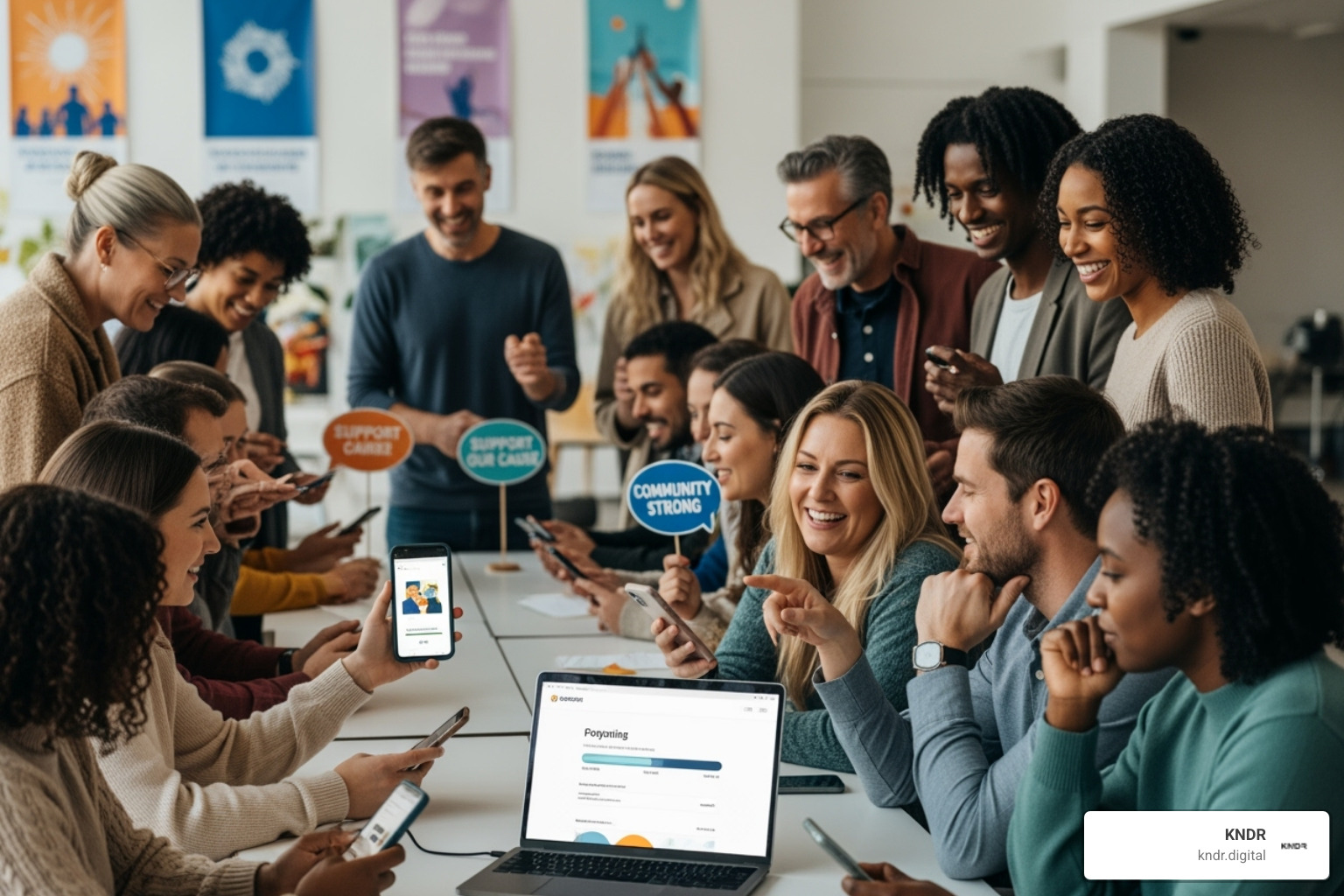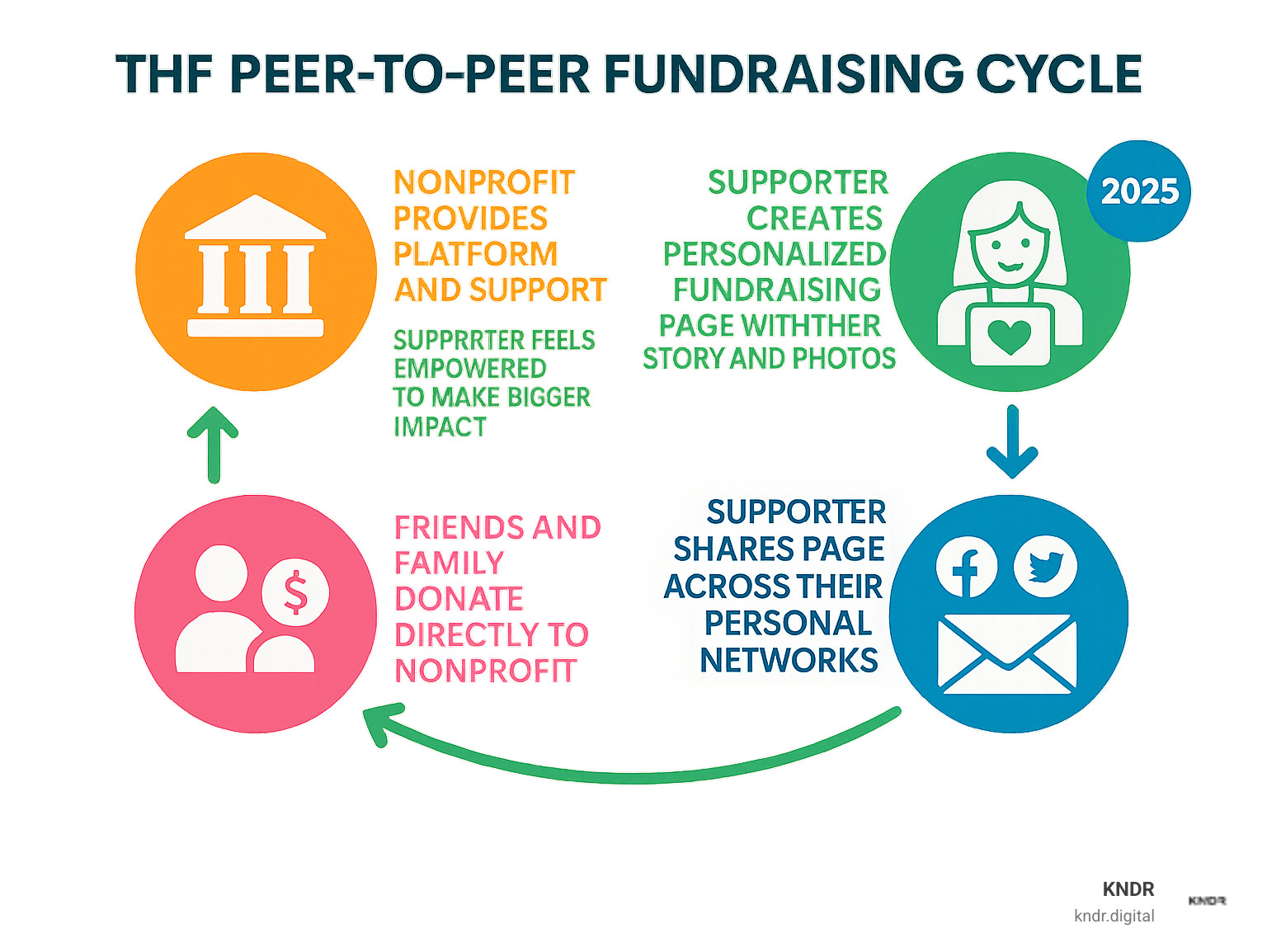Unlocking Peer Power: How Nonprofits Can Master P2P Fundraising

Why Peer-to-Peer Fundraising is Changing Nonprofit Growth
Peer to peer fundraising nonprofit strategies empower your supporters to become active fundraisers. They create personalized campaigns and tap into their networks of family, friends, and colleagues, revolutionizing how you connect with donors and expand your reach.
What is peer-to-peer fundraising for nonprofits?
- Supporters create individual fundraising pages on behalf of your organization.
- They share personal stories and connections to your cause.
- Their networks donate directly to your nonprofit through these pages.
- You gain access to new donors you couldn't reach through traditional methods.
Key benefits include:
- 80% of campaign donors are brand new to the cause (according to recent platform data)
- 39% of Americans donate because of requests from people they know
- 50% donor retention rate - significantly higher than traditional fundraising
- 28% boost in engagement when using diversified communication approaches
The numbers are compelling. America's top 30 P2P programs raised $1.14 billion in 2024, showing consistent post-pandemic growth. The American Heart Association's Heart Walk alone generated $110 million.
But P2P isn't just about money; it's about building authentic relationships. When a friend or family member asks for support, the established trust makes the donation personal, not transactional.
I'm Mahir Iskender, founder and CEO of KNDR. I've helped dozens of nonprofits implement peer to peer fundraising nonprofit strategies that scale their impact. My experience shows how the right AI-powered approach can turn your most passionate supporters into your most effective fundraisers.

Simple guide to peer to peer fundraising nonprofit:
The Foundations: What is P2P Fundraising and Why Does It Work?
At its heart, peer to peer fundraising nonprofit is a strategy where individuals run personal campaigns for a nonprofit. Instead of relying on direct appeals, you empower passionate supporters to become advocates. They create personalized pages, share their connection to your mission, and invite their networks to contribute.
This approach works because it taps into trust. We know that 92% of consumers trust recommendations from people they know. When a friend vouches for a cause, that personal connection builds credibility and lowers the barrier to giving. It's a warm introduction to your nonprofit, not a cold call. This is about building a community of advocates who believe in your work.
P2P fundraising also offers long-term benefits, retaining up to 50% of donors—a crucial metric since retention is more cost-effective than acquisition. The vocal support from fundraisers also boosts brand awareness, as they become authentic ambassadors for your cause, spreading your message far and wide.
The continued post-pandemic rebound of P2P fundraising underscores its resilience. It's not just a passing trend but a sustainable and growing pillar of nonprofit fundraising.

Want to dive deeper into the latest trends? Check out KNDR’s Guide to Top P2P Fundraising Trends.
Why Peer to Peer Fundraising for a Nonprofit is a Game-Changer
For any peer to peer fundraising nonprofit, this model is a transformative strategy. Here's why:
- Expanded Reach and New Donor Acquisition: Your supporters' networks are vast and untapped. Data from leading platforms shows that 80% of campaign donors are brand new to the cause. This means reaching the right people—those connected to someone who already trusts your mission.
- Increased Brand Awareness: Every personalized page and social media share amplifies your brand. Your fundraisers become passionate storytellers, providing organic, authentic promotion that is more powerful than traditional advertising.
- Strengthened Supporter Relationships: P2P fundraising deepens engagement by inviting supporters into an active role. This empowerment strengthens their connection to your organization, building a loyal community. For more insights, explore our guide on Nonprofit Donor Engagement.
- Cost-Effectiveness: You leverage the time and networks of your supporters, rather than investing heavily in traditional marketing. This can lead to a lower cost-per-dollar raised, allowing more funds to go directly to your programs.
Peer-to-Peer vs. Crowdfunding: Understanding the Key Differences
While both peer to peer fundraising nonprofit and crowdfunding raise money from many people, they operate differently. Understanding these distinctions is key to choosing the right strategy.
| Feature | Peer-to-Peer Fundraising | Crowdfunding |
|---|---|---|
| Primary Driver | Personal connections and relationships | Project or idea-based appeal |
| Campaign Structure | Multiple, personalized fundraising pages (one per supporter) | Single, centralized campaign page |
| Focus | Empowering individuals to fundraise for an organization | Funding a specific project, product, or personal need |
| Donor Motivation | Trust in the fundraiser; personal connection to the cause | Interest in the project/idea; direct benefit/reward |
| Reach | Leverages individual social networks | Broader public appeal, often through platform visibility |
| Engagement Type | Relationship-driven, long-term supporter cultivation | Transactional, often one-time contribution |
| Examples | Charity walks, runs, birthday fundraisers for a nonprofit | Campaigns for a new product, funding for a personal need |
Crowdfunding typically involves a single campaign page with a broad narrative, sometimes offering rewards. P2P fundraising empowers volunteers to launch their own personalized pages, leveraging individual connections for a cause. It’s the difference between asking friends to support you in a charity run versus asking strangers to fund a new idea.
The Strategic Blueprint for a Peer to Peer Fundraising Nonprofit Campaign
Planning a successful peer to peer fundraising nonprofit campaign requires a strategic blueprint. Just like planning an event, thoughtful preparation is key to changing excitement into fundraising success.

The foundation of any successful campaign starts with clear goals. Are you aiming to raise $50,000 for new equipment, acquire 200 new donors, or increase community awareness?
Break down your main goal into smaller, manageable targets. For example, to raise $20,000 with 50 fundraisers, each person only needs to raise $400. Specific targets clarify what success looks like.
Next, choose your campaign type and platform. The platform is your campaign's home base, so it must be user-friendly for both your team and your fundraisers. We'll dive into platform selection next.
Don't forget the technical details. Your chosen platform must handle donations securely and scale with your campaign's traffic. For more on building effective campaigns, check out our Digital Fundraising Strategies guide.
Choosing Your Campaign Model
One of the best parts of peer to peer fundraising nonprofit work is its flexibility. You can tailor your campaign to fit your organization's goals and timeline.
- Rolling campaigns are always-on fundraising options. Supporters can start a campaign for a birthday, a personal milestone, or whenever inspiration strikes.
- Time-based campaigns create urgency and typically run for 4-8 weeks. This gives fundraisers enough time to reach their networks without losing momentum.
- Giving days pack fundraising energy into an intense 24-48 hour period. Major giving days demonstrate the power of concentrated, community-wide effort.
- Event-based fundraising combines an activity with peer networks. Walk-a-thons and 5Ks are popular because they are accessible and foster team building.
- Virtual events remove geographical barriers, allowing supporters from anywhere to participate. This flexibility has made fundraising more inclusive than ever.
Choosing the Right Platform for Your Peer to Peer Fundraising Nonprofit
Selecting the right platform for your peer to peer fundraising nonprofit campaign is crucial. You want something that is intuitive for fundraisers and provides a seamless donation experience.
- Ease of setup: Look for platforms with ready-to-use templates that make page creation effortless. If it's too complicated, volunteers won't bother.
- Customization options: Allow fundraisers to add personal photos and stories. These touches create genuine connections with donors.
- Mobile-friendliness: This is essential. Most people will view and donate on their phones, so the experience must be flawless on any device.
- Social sharing tools: Integrated share buttons for social media and email make it simple for supporters to spread the word.
- Gamification elements: Features like fundraising thermometers, leaderboards, and badges add friendly competition and keep people engaged.
- Security and scalability: Your platform must handle high transaction volumes securely. Look for features like PCI compliance, security scanning, and trusted payment processing to protect your donors and your reputation.
- Donor information collection: Since P2P campaigns bring in many new donors, you need to capture their information effectively for future relationship building.
KNDR's platform offers robust P2P fundraising tools designed for nonprofits. Our AI-driven systems create seamless, secure experiences that empower supporters and amplify your reach through automation and comprehensive digital strategies.
For more on managing donor relationships, explore our Donor Management Software guide.
Executing a Winning Campaign: From Recruitment to Promotion
With your blueprint and platform ready, it's time to execute. This phase is about turning passionate supporters into active advocates who will share your mission with their networks.

Your peer to peer fundraising nonprofit campaign succeeds when each fundraiser feels confident, equipped, and excited to be your champion. Success depends on empowering the right people and helping them share their stories. For deeper insights, explore our Nonprofit Donor Engagement Strategies.
Recruiting and Empowering Your Fundraisers
Your fundraisers are your mission's ambassadors, bridging the gap between your nonprofit and new communities of supporters.
- Start with your inner circle. Look to your most engaged supporters: loyal donors, dedicated volunteers, board members, and staff. They already have authentic stories to tell.
- Equip them for success. Create a comprehensive toolkit with platform training, sample emails and social media posts, compelling visuals, and key talking points about your mission.
- Help them find their personal connection. Authentic stories about why your mission matters to them resonate powerfully with their networks. Encourage them to share these personal connections.
- Stay connected. Regular check-ins offer encouragement, answer questions, and celebrate wins. This builds a strong, supportive team.
For broader strategies on building your fundraising community, dive into our guide on Fundraising for Nonprofits.
Creative Campaign Ideas and Promotion
Now it's time to create campaigns that capture imagination and inspire action. The best peer to peer fundraising nonprofit campaigns combine creativity with a genuine connection to your mission.
- Virtual challenges: Ask supporters to complete meaningful tasks related to your cause, like walking a certain distance or reading a number of books.
- Birthday fundraisers: Tap into natural moments of celebration when people are already thinking about gratitude and giving.
- Read-a-thons: These work wonderfully for education-focused nonprofits and engage younger supporters and their families.
- Holiday parties: Integrate fundraising by asking for donations instead of gifts or organizing fun, money-raising activities.
- "Give it up" challenges: Participants give up a daily habit (like coffee) to raise funds and awareness, connecting them more deeply to your cause.
The most successful campaigns align with your mission. If you work on clean water access, challenge supporters to drink only water for a week. This makes the fundraising feel meaningful.
Promotion amplifies everything.
- Social media: Provide fundraisers with eye-catching graphics, videos, and easy-to-share links. Celebrate their efforts publicly.
- Email marketing: Help fundraisers craft heartfelt messages to their contacts, and use your own email list to highlight campaign progress.
- Community partnerships: Local businesses, schools, and community groups can help expand your reach exponentially.
Every share and donation creates ripples of impact. You're not just raising money—you're building a movement.
Optimizing for Maximum Impact: Gamification and Measurement
Once your peer to peer fundraising nonprofit campaign is live, focus on optimizing for maximum impact. This involves using gamification to maintain excitement and measuring key metrics to track what's working.
The beauty of P2P lies in its ability to build connections while tapping into a healthy competitive spirit. Combining smart gamification with solid data tracking creates a more effective and engaging campaign.
Using Gamification to Boost Engagement
Gamification transforms fundraising from a chore into an engaging experience. By adding game-like elements, you tap into a healthy sense of competition and make participation more fun.
- Friendly competition through leaderboards motivates fundraisers to push a little harder by showing how they rank against their peers.
- Fundraising thermometers are powerful visual motivators on personal and campaign pages, showing progress toward a goal.
- Milestone rewards and badges provide continuous motivation by celebrating achievements like the first $100 raised or recruiting five donors.
- Team fundraising goals foster camaraderie and shared responsibility, often leading to higher overall fundraising totals.
For more insights on making fundraising more engaging, explore our Gamification guide.
Measuring the Success of Your Campaign
You can't improve what you don't measure. The data from your peer to peer fundraising nonprofit campaign provides the story and insights needed to guide future success.
- New donors acquired: This may be your most valuable metric, representing your campaign's true growth potential.
- Average donation size: This helps you understand donor behavior and plan realistic revenue projections.
- Fundraiser activation rate: This reveals how well you're supporting your volunteers. A high activation rate (70% or more) indicates your training and platform are effective.
- Social media reach and engagement: This shows how far your message is traveling organically, which is one of P2P's greatest strengths.
- Donor retention rate: This metric speaks to long-term sustainability. P2P campaigns can have significantly higher retention rates, increasing the lifetime value of your investment.
Analyzing this data together helps you build a playbook for future success by revealing what messaging, channels, and fundraisers performed best.
Our AI-Driven Fundraising approach helps nonprofits turn this data into actionable insights. For deeper analysis, check out The Complete Guide to AI-Powered Donor Segmentation.

Frequently Asked Questions about P2P Fundraising
Here are answers to the most common questions we hear from nonprofit leaders about running a peer to peer fundraising nonprofit campaign.
How long should a peer-to-peer campaign run?
The ideal campaign length depends on your model:
- Time-based campaigns: 4 to 8 weeks is the sweet spot. It provides enough time to build momentum without losing urgency.
- Giving Days: These are intense 24 to 48-hour campaigns that thrive on a sense of urgency and concentrated effort.
- Rolling campaigns: These are ongoing, allowing supporters to fundraise anytime. This is great for birthdays, personal milestones, and long-term engagement.
The key is to match your timeline to your goals. A specific event benefits from the urgency of a time-based campaign, while long-term relationship building is suited for rolling campaigns.
Can we include offline donations in our campaign totals?
Yes. It's crucial to track all contributions. A robust platform like KNDR's allows for the manual entry of offline donations (cash and checks). This ensures these funds are reflected on fundraising thermometers and leaderboards, giving a complete picture of your progress and validating every fundraiser's efforts.
This transparency builds confidence among donors and fundraisers, as it shows that all contributions are being properly tracked and recognized.
Is P2P fundraising only for large nonprofits?
No, this is a common myth. P2P fundraising is highly effective for nonprofits of all sizes. It allows smaller organizations to leverage their most valuable asset: passionate supporters.
The power of P2P comes from personal trust, not organizational size or budget. A small animal rescue with a handful of dedicated volunteers can run a P2P campaign that reaches hundreds of new donors. The beauty of P2P is that it scales with your community's passion, not your budget.
Your supporters' personal networks care about the authentic connection their friend has to your cause, not your annual budget.
Conclusion: Using Community Power for Your Mission
Peer-to-peer fundraising shows that your supporters want to do more than just donate—they want to be active champions for your cause. This peer to peer fundraising nonprofit strategy helps them share their passion and create genuine, lasting connections.
When someone personally asks you to support something they care about, you listen. That's the magic of P2P. It taps into the most powerful force in fundraising: authentic human relationships built on trust.
This approach is about more than just raising money today; it's about building a sustainable community for tomorrow. Each personal fundraising page is a doorway to new donors, relationships, and long-term impact.
This strategy is accessible to all nonprofits, regardless of size. Your passionate supporters become your most effective ambassadors, sharing authentic stories that carry your mission into new networks.
The future of fundraising is personal and community-driven. AI-powered tools make it easier to support fundraisers and optimize campaigns, but success still comes down to people caring enough to ask their networks for support.
Your community is waiting to be empowered. Give them the tools and encouragement to fundraise on your behalf, and you will not only expand your reach but also deepen the relationships that fuel your mission.
At KNDR, we've seen how the right technology and strategy can transform these relationships into extraordinary results. Our AI-driven approach doesn't replace the human element; it amplifies it, helping you turn passion into measurable success.
Ready to turn your supporters into fundraising champions and open up your community's full potential? Find how KNDR can amplify your fundraising efforts and see what happens when passion meets the right strategy.


